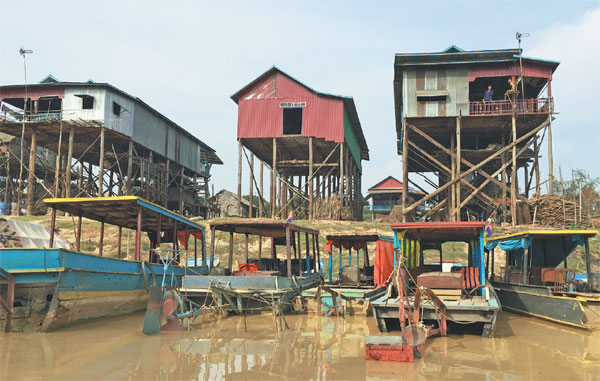Going beyond Angkor wat
Updated: 2016-04-04 09:12
By Craig Mcintosh(China Daily)
|
||||||||
Besides the famous temple ruins, this country also boasts beautiful beaches, wildlife and a fascinating modern history
After watching the sun slowly sink into the horizon, we dived into the water with our snorkels and were immediately surrounded by a galaxy of "stars".
The spectacle, created by bioluminescent plankton, can be witnessed inmost places along the southwestern coast of Cambodia and is a treat for any nighttime swimmer.
|
When the water level in Cambodia's Tonle Sap Lake drops, the long stilts supporting homes in Kampong Phluk, a floating village, are left exposed. Photos by Shen Ye / For China Daily |
|
Clockwise from top left: The night market in Siem Reap is the place to find souvenirs and local handicrafts; inside the Royal Palace in the capital, Phnom Phen; Otres beach in Sihanoukville offers a calm, laid-back experience; a relic of the Cambodian civil war, one of many on display at the War Museum. |
Our small group had moored a boat near the coral off Bamboo Island, a short ride from the white-sand beaches of Sihanoukville. As dusk approached, we drank a beer and enjoyed the silence, which was broken only by our captain performing acrobatic dives from the hull into the warm, clear water.
When darkness fell, the sparkling plankton came alive, providing just one of the many visual feasts that visitors to this country can expect.
Although largely known for the Angkor Wat Archeological Park, a massive collection of centuries-old ruins in the north, and the Khmer Rouge, Cambodia also boasts beautiful beaches, forests and wildlife reserves, as well as myriad sites providing insight into the country's fascinating yet often harrowing modern history.
For many tourists, Phnom Penh, the capital, is the first port of call. While not the most picturesque place, it does offer a taste of modern Cambodian life.
The city's two main attractions are the National Museum and the Royal Palace, both a short walk of each other in the center of town. The museum ($5 admission) houses a modest collection of ancient artifacts, but you can probably skip it if you're planning on heading to Siem Reap, which has the larger and more-impressive Angkor National Museum.
A visit to the stunning Royal Palace (a rather steep $13 entry fee) will take only about an hour, with several exhibition areas added in recent years to give a fuller visitor experience. Paying $10 for a guide is worth it to learn more about the history. The palace is open 9-11 am and 2-5 pm, but its best to visit early to avoid the afternoon heat.
Around the museum and palace are dozens of restaurants offering Khmer and Western options and coffee shops, while Street 240, just around the corner, is lined with boutique stores selling clothes, organic foods and cosmetics.
Head to Sisowath Quay, which offers views of where Tonle Sap River merges with the Mekong River, and walk north and you will quickly arrive at the city's tourist center, ideal for shopping, dining and drinking. When the sun goes down, however, the area can feel a little seedy, and you need to be careful with your belongings.
A tuk tuk can also be hired to take you to the Killing Fields, about 17 kilometers to the south, where the Khmer Rouge executed many of its victims during its four-year reign. Today, the site features a Buddhist stupa packed with thousands of skulls. A visit here can be combined with the Tuol Sleng Genocide Museum, a former prison.
Life's a beach
Ultimately, one or two days are enough in Phnom Penh. From here, most head to the splendid ruins of the north or to the relaxing beaches and sea views of the southwest.
We took a minibus southwest ($10 a seat) and arrived just under five hours later in Sihanoukville. This coastal city has a beach for all tastes: from Serendipity and Ochheauteal, backpacker favorites and nighttime party spots, to Otres, a laid-back stretch about 10 minutes from the center.
Kayaks, jet skis and surfing equipment can be hired at most beaches, while boat tours and ferries are available to take you to the outlying islands, such as Koh Rong (also known as Monkey Island) or the smaller but equally calm Koh Takiev. The islands all have beach bungalows for those who want to stay overnight.
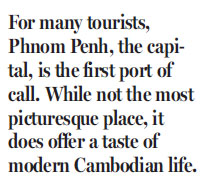
As many tour operators stick to a fairly rigid schedule and tend to overload their vessels, we opted instead to rent a private boat for a day ($50 after haggling), which allowed the luxury of staying out after dark to snorkel among the sparkling plankton.
From here, you can also visit Kampong Nup Lok, an old fishing village that offers some nice views, and Ream National Park, a large mangrove nature reserve about 30 minutes' drive east. A boat tour to the park will cost about $25, but they can be disappointing. Alternatively, you can arrive there by tuk tuk and hire a park ranger to lead you on a walking tour (usually $5, although best to call ahead).
After relaxing on the beach for a few days, we boarded a plane at Sihanoukville airport bound for Siem Reap. Flying takes about an hour, although buses are available and take about eight to 10 hours.
Ancient history
Siem Reap boasts Cambodia's most famous attraction, while the city itself has grown into a fun and relaxing destination for international travelers.
A visit here would not be complete without a tour of the 12th century Angkor Wat and the many other ancient and varied temples "rediscovered" by French explorers about 300 years ago.
Most are located within two circuits to the north, both of which take a good 10 hours to cover, either starting at sunrise or finishing at sunset. Those in town for only a day or two will probably be content with the smaller of the two, which includes Angkor Wat and Bayon. However, if you do have the time, doing both circuits and adding a third day to see sites further out, such as the 1,000 year-old Banteay Srei or the jungle-covered Beng Melea, is well worth it to see the variations in carving styles and architecture.
Trips to temples further out can also be combined with other activities, such as a visit to the Landmine Museum ($5), which raises awareness and money for families affected by landmines, and Bantreay Srei Butterfly Park ($4).
For those interested in learning about Cambodia's recent history, the War Museum ($5), not far from the city center, features a comprehensive collection of weaponry and photos from the civil war. Guides offer free tours and most themselves are former soldiers who can regale visitors with firsthand accounts of the conflict.
Just to the south of Siem Reap is the vast Tonle Sap Lake, which is surrounded by floating villages and boasts abundant wildlife.
Chong Khneas, a small fishing community, is probably the most popular among tourists, but you can escape the crowds by heading out early to Kampong Phluk. In the dry season (November to April), you can see the tall stilts that support the houses, offering an otherworldly experience. When the rain arrives, travel here can be accomplished only by boat.
After a tiring tour in Siem Reap's beautiful wilderness, you'll be spoiled for choice on where to unwind. Most of the city's nightlife is spread between three areas - Old Market, Wat Damnak and Wat Bo - and all have an abundance of bars, restaurants, markets, and massage parlors.
The only downside is that you may never want to leave.
Contact the writer at craig@chinadaily.com.cn
Things to know
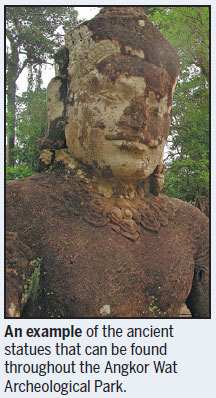
Money: The riel is the official currency of Cambodia, but US dollars are more commonly used by businesses, even in the markets. Riel is generally used for only small purchases. ATMs accept most bankcards, including Union Pay. Check your change, though, as stores and restaurants will not accept notes that are even slightly ripped, nor can you use $2 notes.
Visas: Landing visas for tourists cost $30 per person at custom entry points in Phnom Penh and Siem Reap. Try to fill out the paperwork on the plane to save time, and if possible pay with the exact money.
Scams: Be wary of staff members inside temples who demand an extra fee to enter "closed-off" sections; more often than not they are the ones who closed off that section. Also, the people casually offering incense near statues will expect money if you take it off them.
NGOs, orphanages: There are many ways in which tourists can contribute to aid organizations, such as buying from stores that support impoverished families, eating at restaurants that help vulnerable young adults, or donating blood. However, carefully research any orphanage you plan to visit, as some are scams using children to profit from the so-called pity industry.
(China Daily 04/04/2016 page10)
- Two new imported Zika cases in S China
- N China's largest photovoltaic project begins to join power grid
- New laws aim at ensuring nuclear safety
- Big floods along Yangtze River likely, authorities warn
- Chinese tweak tradition to adopt eco-friendly burials
- Shanxi digs deep to eradicate coal overcapacity
- Xi: Talks 'only correct way' for China, ROK
- Xi to Obama: Disputes should be managed
- Cypriot court remands in custody man suspected of hijacking EgyptAir flight
- Govt eyes luxury tourists amid concerns over safety
- Sleep tight and don't let sharks bite at Paris aquarium
- Aung San Suu Kyi appointed as Myanmar's new foreign minister

 Xi tells Obama disputes should avoid misunderstandings
Xi tells Obama disputes should avoid misunderstandings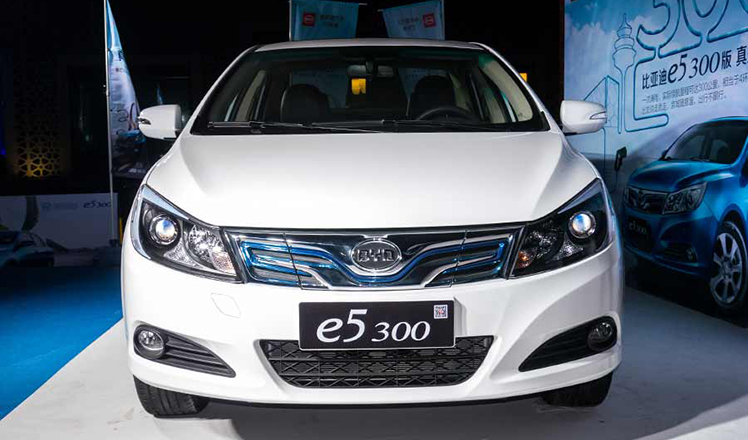
 BYD launches two new electric models, Qin EV and e5
BYD launches two new electric models, Qin EV and e5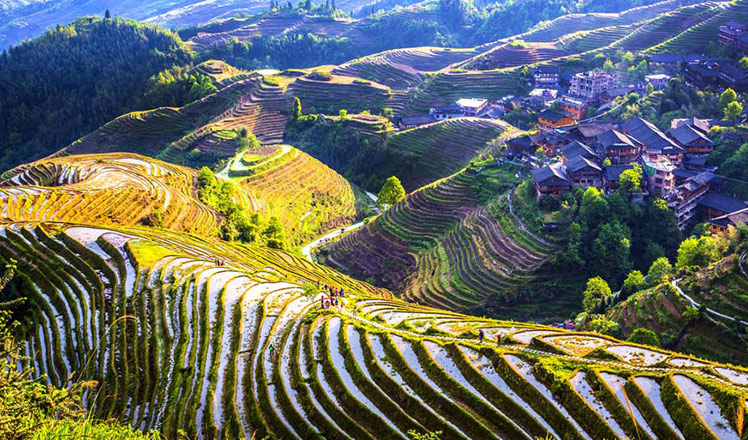
 Discover beautiful China in Spring blossom (II)
Discover beautiful China in Spring blossom (II)
 Xi calls for bigger progress in China-Denmark ties
Xi calls for bigger progress in China-Denmark ties
 China move into the final stage of Asia qualifiers after 15 years
China move into the final stage of Asia qualifiers after 15 years
 Grief, anger engulf Taiwan as suspected killer of girl arrested
Grief, anger engulf Taiwan as suspected killer of girl arrested
 Stolen Buddha statue head arrives in Hebei museum
Stolen Buddha statue head arrives in Hebei museum
 Top 10 best-selling beers in the world
Top 10 best-selling beers in the world
Most Viewed
Editor's Picks

|

|

|

|

|

|
Today's Top News
Marriott unlikely to top Anbang offer for Starwood: Observers
Chinese biopharma debuts on Nasdaq
What ends Jeb Bush's White House hopes
Investigation for Nicolas's campaign
Will US-ASEAN meeting be good for region?
Accentuate the positive in Sino-US relations
Dangerous games on peninsula will have no winner
National Art Museum showing 400 puppets in new exhibition
US Weekly

|

|
